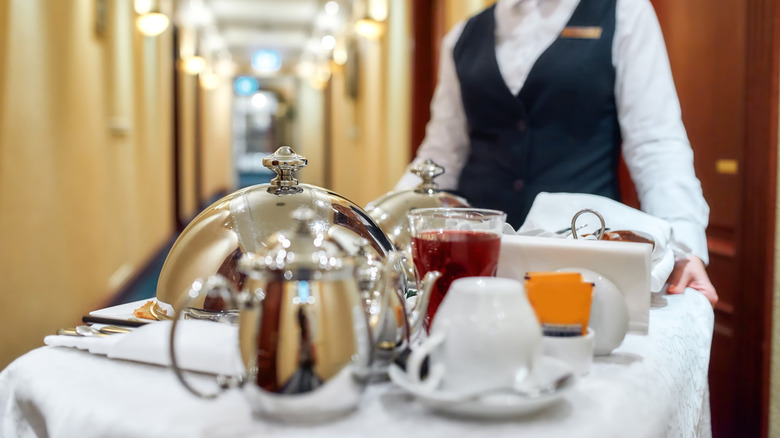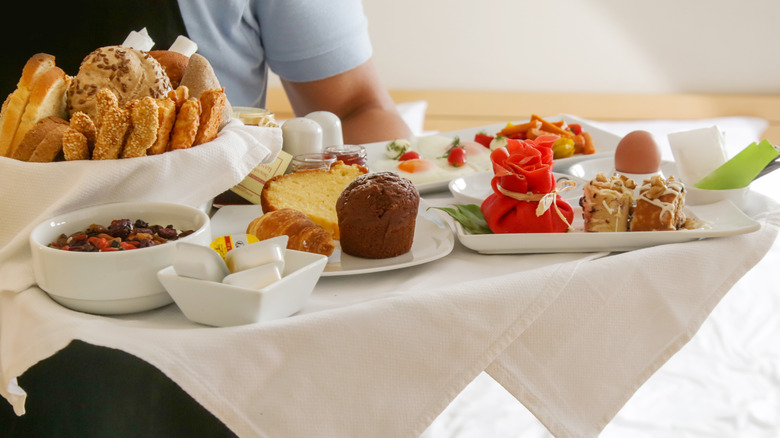The Extravagant Origins Of Hotel Room Service And How It Evolved
We may receive a commission on purchases made from links.
Hotel room service is an indulgence many of us — especially business travelers — take for granted. It's not always about breakfast in bed or lazing around nibbling on chocolate-covered strawberries while sipping Champagne. More often, ordering room service is about convenience — breakfast on the run or a working dinner. Either way, it's kind of an afterthought. A bit like elevator music. It's always there in the background, but only ebbs into our consciousness when we need it, whether for convenience or indulgence. It's so ingrained in our collective consciousness that it's difficult to imagine a time before room service, a time when dining required getting dressed — appropriately, no comfy athleisure wear allowed— and dragging yourself to the hotel restaurant was the norm.
So who came up with the idea of hotel room service? Credit for that innovation goes to New York City's iconic Waldorf Astoria Hotel. In 1929, the original hotel was demolished to make way for construction of the Empire State Building (an attraction with some incredibly long lines). Opened in 1893, the original establishment had earned a reputation as one of the world's most opulent hotels during its nearly 50 years in service — and its final 10 years under the leadership of early 20th-century hotelier Lucius M. Boomer. Boomer, by some accounts a hospitality visionary, had the foresight to purchase the name Waldorf Astoria — for $1. Two years later, in 1931, he opened the Waldorf Astoria Hotel at its current location on the corner of Fifth Avenue and 33rd Street. Located at 301 Park Ave., the hotel's façade earned protected landmark status in 1993. It is now just reopening again after a decade of renovations. Boomer had big plans to ensure the Waldorf Astoria maintained its elite status, furnishing it with more bells and whistles — including the heretofore unheard concept of room service — than anyone at the time could imagine.
Room service was a trend-setting innovation
In addition to offering room service, Boomer invested in other precedent-setting innovations like installing electricity throughout the hotel, incorporating en-suite bathrooms into guest room design, and furnishing each guest room with a telephone. In an interesting twist, it seems Boomer's plan to offer room service was more about ensuring guest privacy than offering an indulgent amenity. In fact, room service was only one of many concessions the hotel afforded its wealthy clientele. Other innovations included entrances, elevators, and hallways carefully designed to ensure high-profile guests could come and go without drawing attention. There's even a secret train station. Located beneath the hotel, the station was built in the 1930s so President Franklin Delano Roosevelt could enter and exit without revealing his polio diagnosis.
The hotel's early room service menus were as impressive as its secret spaces. Filet mignon ($6.25 in the 1930s) and Maine lobster salad ($4.60) were mainstays. And while the origins of eggs Benedict are widely disputed, one theory holds it all goes back to an early Waldorf Astoria room service order. Rumor has it that Lemuel Benedict, a retired Wall Street stockbroker, was staying at the hotel when he ordered a slightly unusual, but highly specific egg preparation. Apparently, it was his tried-and-true hangover remedy. The chef successfully created the dish according to Benedict's instructions and subsequently made a few tweaks before adding it to the hotel's room service menu. Almost a century later, room service has become a standard hotel amenity — and hotel guests continue to make specific, sometimes unusual, demands. According to a 2023 survey published by Hotels.com, some of the most memorable room service orders in recent history include melted ice cream and diet water. The most popular room service order? A good old-fashioned hamburger.

